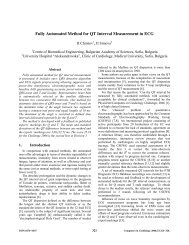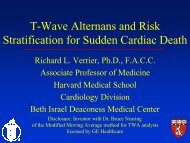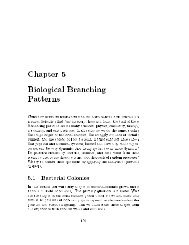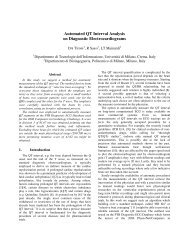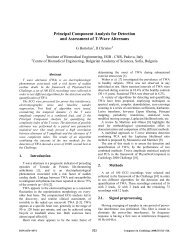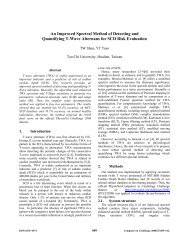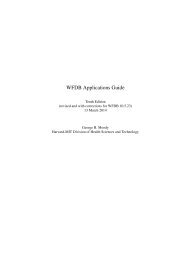Heart rate characteristics monitoring to detect neonatal ... - PhysioNet
Heart rate characteristics monitoring to detect neonatal ... - PhysioNet
Heart rate characteristics monitoring to detect neonatal ... - PhysioNet
Create successful ePaper yourself
Turn your PDF publications into a flip-book with our unique Google optimized e-Paper software.
<strong>Heart</strong> <strong>rate</strong> <strong>characteristics</strong><br />
<strong>moni<strong>to</strong>ring</strong><br />
<strong>to</strong> <strong>detect</strong> <strong>neonatal</strong> sepsis<br />
Pam Griffin<br />
Randall Moorman<br />
University of Virginia<br />
Equity: Medical Predictive Science Corporation, Charlottesville
METHOD<br />
• Pick the right problem.<br />
Little babies are dying.
Neonatal Sepsis: A Major<br />
Public Health Problem<br />
• Of 4 million births each year, 56,000 are very<br />
low birth weight infants (VLBW,
Is this baby septic?<br />
• The diagnosis of<br />
<strong>neonatal</strong> sepsis is<br />
difficult<br />
• The outcome of<br />
sepsis is<br />
potentially<br />
catastrophic<br />
• Leading<br />
physicians <strong>to</strong>:<br />
– obtain lab tests<br />
– administer antibiotics<br />
early and often
METHOD<br />
• Pick the right problem.<br />
• Look at the data.<br />
We observed reduced variability and transient<br />
decelerations prior <strong>to</strong> clinical illness and death.
200<br />
150<br />
100<br />
200<br />
150<br />
100<br />
0 10 20 30<br />
Time (min)<br />
0 10 20 30<br />
Time (min)<br />
Hours prior <strong>to</strong><br />
death<br />
>150<br />
<strong>Heart</strong> <strong>rate</strong> (BPM)<br />
250<br />
200<br />
150<br />
100<br />
250<br />
200<br />
150<br />
100<br />
250<br />
200<br />
150<br />
100<br />
5<br />
Time (minutes)<br />
10<br />
Hours prior <strong>to</strong><br />
dx of sepsis<br />
>150<br />
6<br />
3
Normal heart <strong>rate</strong> <strong>characteristics</strong><br />
many small<br />
decelerations<br />
many small<br />
accelerations<br />
His<strong>to</strong>gram of heart <strong>rate</strong>s<br />
decelerations<br />
accelerations
Abnormal heart <strong>rate</strong> <strong>characteristics</strong><br />
many large<br />
decelerations<br />
few or no<br />
accelerations<br />
His<strong>to</strong>gram of heart <strong>rate</strong>s<br />
decelerations accelerations
METHOD<br />
• Pick the right problem.<br />
• Look at the data.<br />
• Assume nothing.<br />
Conventional HRV measures do not <strong>detect</strong><br />
reduced variability and transient<br />
decelerations, so we made some up.
HRC algorithm development<br />
• Mathematical analysis of reduced<br />
variability and transient decelerations<br />
– standard deviation<br />
– sample asymmetry<br />
– sample entropy<br />
• Biostatistical analysis of HRC prior <strong>to</strong><br />
clinical diagnosis of <strong>neonatal</strong> sepsis<br />
– multivariable logistic regression<br />
• Result: an on-line continuous estimate of<br />
the risk of sepsis in the next 24 hours,<br />
based on the degree of reduced variability<br />
and transient decelerations
Predictive model – study design<br />
“Well”<br />
“Sick”<br />
CRASH<br />
18 0 6 12 18 0 6 12 18 0 …. Blackout<br />
time of day in hours<br />
CRASH = Cultures, Resuscitation, & Antibiotics Started Here<br />
Epochs were defined as “well”(more than 24 hours prior <strong>to</strong> CRASH event),<br />
“sick”, or a 14-day “blackout” period that was not analyzed.
Predictive model - HRC index<br />
The HRC index is derived from regression modeling and uses<br />
HRC measures of standard deviation (S.D.), Sample<br />
Asymmetry (R1 and R2), and SampEn <strong>to</strong> estimate the risk of<br />
upcoming sepsis and sepsis-like illness.<br />
The formula for the HRC index is:<br />
where:<br />
HRC index = [exp(A) / 1+exp(A)]<br />
A = intercept + β 1 (S.D.) + β 2 (R1) + β 3 (R2) + β 4 (SampEn)<br />
We derived the intercept and coefficients β using UVa data,<br />
and then calculated the HRC index for WFU data.
HRC INDEX PREDICTS<br />
SEPSIS AT 2 NICUs<br />
TRAIN AT UVa:<br />
316 infants;<br />
155 events in<br />
101 infants<br />
TEST AT WFU:<br />
317 infants;<br />
118 events in 93<br />
infants<br />
result: formula for<br />
HRC index<br />
HRC index is<br />
associated with<br />
sepsis and sepsis-like<br />
illness<br />
p
Fold-increase in risk<br />
6<br />
5<br />
4<br />
3<br />
2<br />
1<br />
HeRO 2 or more<br />
High risk – <strong>to</strong>p 10%<br />
HeRO 1 <strong>to</strong> 2<br />
Intermediate risk – 70 <strong>to</strong> 90%<br />
HeRO 1 or less<br />
Low risk – bot<strong>to</strong>m 70%<br />
0 25 50 75 100<br />
HRC index, as percentile
HRC index rises prior <strong>to</strong> sepsis<br />
Term infant<br />
Premature infant<br />
Fold-increase in odds risk<br />
7<br />
6<br />
5<br />
4<br />
3<br />
2<br />
1<br />
0<br />
CRASH<br />
21 28 35 42<br />
Fold-increase in odds risk<br />
5<br />
4<br />
3<br />
2<br />
1<br />
CRASH<br />
0<br />
28 35 42 49<br />
Days post-natal<br />
Days post-natal
A<br />
fold-increase in risk<br />
2<br />
1<br />
0<br />
a<br />
Symp<strong>to</strong>ms: none<br />
Labs: normal<br />
BC: Serratia marcescens<br />
-6 -4 -2 0 2<br />
Time relative <strong>to</strong> blood culture (days)<br />
b<br />
c<br />
200<br />
a<br />
200<br />
b<br />
200<br />
c<br />
150<br />
150<br />
150<br />
100<br />
100<br />
100
HRC rises before illness score<br />
3.0<br />
Clinical score<br />
1.5<br />
1.0<br />
0.5<br />
HRC index<br />
clinical score<br />
**<br />
*<br />
*<br />
*<br />
*<br />
* * *<br />
2.5<br />
2.0<br />
1.5<br />
HRC index (fold-increase)<br />
0.0<br />
1.0<br />
-4 -2 0 2 4<br />
Time relative <strong>to</strong> event (days)
Fate of HRC<br />
(VLBW infants)<br />
Incidence of adverse events<br />
0.20<br />
0.15<br />
high<br />
0.10<br />
intermediate<br />
0.05<br />
low<br />
0.00<br />
0 1 2 3 4 5 6 7<br />
Time (days)<br />
Relative risk of adverse events<br />
4<br />
3<br />
2<br />
high<br />
intermediate<br />
1<br />
low<br />
0<br />
0 1 2 3 4 5 6 7<br />
Time (days)
A <strong>neonatal</strong> sepsis risk scorecard<br />
HRC index<br />
Not<br />
measured<br />
Low<br />
Intermediate<br />
High<br />
Clinical score<br />
Not<br />
measured<br />
0<br />
1<br />
≥2<br />
1.0<br />
0.7<br />
2<br />
3<br />
0.5<br />
0.5<br />
1<br />
3<br />
1<br />
1<br />
2<br />
3<br />
3<br />
2.5<br />
4<br />
4
METHOD<br />
• Pick the right problem.<br />
• Look at the data.<br />
• Assume nothing.<br />
• Do a randomized trial.<br />
1 R01-HD 048562-01<br />
“Impact of <strong>neonatal</strong> heart <strong>rate</strong> <strong>characteristics</strong>”<br />
ClinicalTrials.gov identifier NCT 00307333
Does HRC display improve<br />
outcomes in the NICU?<br />
admission <strong>to</strong> NICU<br />
randomize<br />
HRC display<br />
no HRC display<br />
outcome measures:<br />
•ventila<strong>to</strong>r-free days during<br />
first 120 days of life (primary)<br />
•days in hospital<br />
•days on antibiotics<br />
•in-hospital mortality
Mathematical analyses of<br />
<strong>neonatal</strong> heart <strong>rate</strong><br />
• Empirical cumulative distribution functions and<br />
the Kolmogorov-Smirnov two-sample test (Cao)<br />
– Neonatal HR is non-stationary, and even less so prior <strong>to</strong> sepsis.<br />
• Nearest-neighbor analysis and <strong>to</strong>urnaments of<br />
models (Xiao)
Birth weight<br />
neighborhood<br />
WBC<br />
Day of age<br />
New data point<br />
healthy<br />
neighbor<br />
septic<br />
neighbor
Invitational <strong>to</strong>urnament<br />
HRC index<br />
worse<br />
WBC<br />
I:T ratio<br />
worse<br />
HCO 3<br />
worst<br />
Are the biggest pessimists the best predic<strong>to</strong>rs of sepsis?
Results<br />
•Nearest-neighbor analysis added independent information <strong>to</strong><br />
logistic regression (p
Mathematical analyses of<br />
<strong>neonatal</strong> heart <strong>rate</strong><br />
• Empirical cumulative distribution functions and<br />
the Kolmogorov-Smirnov two-sample test (Cao)<br />
• Nearest-neighbor analysis and <strong>to</strong>urnaments of<br />
models (Xiao)<br />
• Deceleration <strong>detect</strong>ion using wavelet transform<br />
analysis (Flower)
Wavelet transform analysis of decelerations<br />
amplitude<br />
scale<br />
location
Wavelet transform analysis of decelerations<br />
Baseline heart <strong>rate</strong><br />
variability<br />
=<br />
+<br />
Detected decelerations<br />
Raw data with fitted<br />
wavelet templates<br />
superimposed
Some infants had s<strong>to</strong>rms of decelerations<br />
BW 1285 g, GA 29 weeks<br />
Day 18 of life<br />
2 hours before<br />
Klebsiella sepsis<br />
175<br />
150<br />
125<br />
100<br />
75<br />
175<br />
BW 1005 g, GA 27 weeks<br />
Day 21 of life<br />
7 hours before<br />
Pseudomonas sepsis<br />
150<br />
125<br />
100<br />
75
These s<strong>to</strong>rms were highly predictive of sepsis<br />
Number of 4096-beat records<br />
10 5<br />
10 4<br />
10 3<br />
10 2<br />
15<br />
10<br />
5<br />
0<br />
0 1 2 3 4 5 6 7 8<br />
Number of decelerations<br />
Fold-increase in sepsis within 24 hours
Decelerations add information<br />
<strong>to</strong> the HRC index<br />
predic<strong>to</strong>r 1<br />
predic<strong>to</strong>r 2<br />
ROC<br />
p1<br />
p2<br />
S.D. of RR<br />
intervals<br />
0.70<br />
*<br />
S.D. of RR<br />
intervals<br />
number of<br />
decelerations<br />
0.75<br />
*<br />
*<br />
HRC index<br />
0.75<br />
*<br />
HRC index<br />
number of<br />
decelerations<br />
0.77<br />
*<br />
*<br />
S.D. = standard deviation; p1 is for significance of predic<strong>to</strong>r 1;<br />
p2 is for added information of predic<strong>to</strong>r 2; * =
Mathematical analyses of<br />
<strong>neonatal</strong> heart <strong>rate</strong><br />
• Empirical cumulative distribution functions and<br />
the Kolmogorov-Smirnov two-sample test<br />
• Nearest-neighbor analysis and <strong>to</strong>urnaments of<br />
models<br />
• Deceleration <strong>detect</strong>ion using wavelet transform<br />
analysis<br />
• Entropy estimation:<br />
– ApEn is biased, but Sample Entropy (SampEn) is less so (Richman).<br />
– Low values of entropy can arise from spikes in the data (Lake).<br />
– Atrial fibrillation <strong>detect</strong>ion based on entropy requires only short records<br />
(Lake, Xiao).<br />
– Closed form estimates of the variance of SampEn (Richman, Lake)…<br />
– …allow optimization of m and r (Lake, Rush<strong>to</strong>n, Xiao).
Entropy estimation<br />
bars are<br />
r(S.D.)<br />
A = match of length m+1<br />
B = match of length m<br />
Sample Entropy = -ln ΣA / ΣB<br />
Approximate Entropy ≈ Σ -ln (1+ΣA) / (1+ΣB)<br />
For regular, repeating data, ΣA / ΣB nears 1 and<br />
entropy nears 0.
Toward improved<br />
entropy estimates<br />
• Signal x 1 ,x 2 ,…,x n<br />
•X i (m)= (x i-m+1 ,…, x i ) template i of length<br />
m<br />
•B i =number of matches with X i (m)<br />
•A i =number of matches with X i (m+1)<br />
•B=ΣΒ i =number of matches of length m<br />
•A=ΣA i =number of matches of length<br />
m+1<br />
• Conditional probability: p=A/B<br />
• SampEn=-log(p)
Conditional probability variance<br />
σ<br />
2 1 2 2 2 2<br />
σ<br />
p<br />
=<br />
2 ( σ<br />
A<br />
− 2 pσ AB<br />
+ p σB<br />
)<br />
4B<br />
n K n−h<br />
2 2<br />
∑ ∑<br />
A i i i+<br />
h<br />
i= 1 h= 1 i=<br />
1<br />
= n∑( A − A/ n) + 2 n ( A −A/ n)( A − A/ n)<br />
σ<br />
K<br />
2<br />
AB i j<br />
h=−K | i− j|<br />
= h<br />
= ∑ ∑ − −<br />
Cov[A,B]= n ( A A/ n)( B B/ n)<br />
• Fac<strong>to</strong>r of 4 needed <strong>to</strong> account for counting each match twice<br />
• K selected based on correlation length of signal and m<br />
• Conservative estimate is maximum value among all K
Estimated SampEn Standard Error<br />
• Above estimate more accu<strong>rate</strong> and generally<br />
smaller than that previously reported (Lake et<br />
al, 2002) and available on Physionet<br />
• Estimate motivated by more accu<strong>rate</strong> U-<br />
statistic approach of Richman (Ph.D.<br />
dissertation 2005)<br />
• New estimate requires less computation and<br />
agrees favorably on MIT-BIH NSR data base<br />
• Standard error of SampEn is approximately<br />
standard error of p divided by p
Relative error of the SampEn estimate<br />
Atrial fib Normal sinus rhythm CHF<br />
m<br />
m<br />
0<br />
1<br />
2<br />
3<br />
4<br />
5<br />
6<br />
7<br />
0<br />
1<br />
2<br />
3<br />
4<br />
5<br />
6<br />
7<br />
0 20 40 60 0 20 40 60 0 20 40 60<br />
r (msec)<br />
0 20 40 60 0 20 40 60 0 20 40 60<br />
ROC areas<br />
AF vs NSR AF vs CHF NSR vs CHF<br />
0.3<br />
0.0<br />
1.00<br />
0.65
Acknowledgments<br />
University of Virginia<br />
•Doug Lake<br />
•Boris Kovatchev<br />
•Frank Harrell/Doug Wagner<br />
•Hanqing Cao (Susan)<br />
•Abby Flower<br />
•Yuping Xiao<br />
•Ben Rush<strong>to</strong>n<br />
MPSC<br />
•Will King<br />
•Scott Booth<br />
Wake Forest<br />
•Mike O’Shea<br />
UAB<br />
•Wally Carlo<br />
Wm&Mary<br />
•John Delos<br />
George Beller<br />
John Kattwinkel<br />
Brian Duling<br />
CIT, CMC, AHA, NIH




